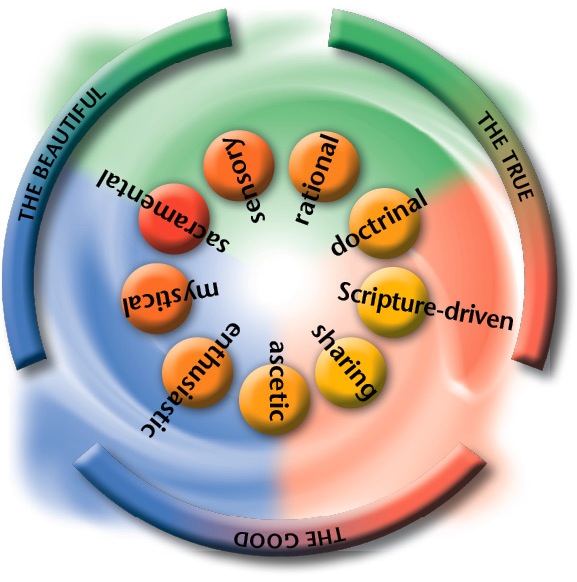What fascinates me about my sacramental mentor Jonathan
J
When asking Father Jonathan if NCD was suitable for the Orthodox Church, his answer was clear: “Yes, because it has worked. The results of those churches that have been involved with NCD are very encouraging.“ In the past few years he has inspired quite a number of Orthodox churches to launch the NCD process. I have visited some Orthodox churches—those in which the NCD Survey revealed a high quality, and those that have a relatively low quality. In both cases, the things happening in the worship services were exactly the same. It is the same liturgy. People light candles, chat with their neighbor, pray in front of an icon, or remain silent in God‘s presence. Externally, the quality increase hasn‘t changed anything about the worship service. And yet, the differences between churches with high and low quality are almost physically palpable.
 Graphical representation of the sacramental style: It is essential to understand the positioning of this style within the Trinitarian Compass. Christians with a sacramental style should take into special consideration the two opposite styles (Scripture-driven and sharing) as these throw light on the dark side of the sacramental style.
Graphical representation of the sacramental style: It is essential to understand the positioning of this style within the Trinitarian Compass. Christians with a sacramental style should take into special consideration the two opposite styles (Scripture-driven and sharing) as these throw light on the dark side of the sacramental style.
On the one hand, the sacramental style falls exactly on the interface between the blue and the green style families; on the other hand, it is at the very center of the aesthetic style family. Depending on its leaning toward one of its two neighbor styles, it can manifest itself in a more mystical (blue) or sensory variety (green). For Christians with a sacramental style, it is most natural to express their spirituality through a connection between sensory perception and spiritual reality. The strength of this style is its appreciation for symbols and tradition; the peril is to perform the respective rites without inner participation (ritualism).
 Christians with a sacramental style love to express spiritual realities in physical ways. Among other things, this makes them very receptive to symbols, rites, and architecture.
Christians with a sacramental style love to express spiritual realities in physical ways. Among other things, this makes them very receptive to symbols, rites, and architecture.
To those approaching the sacramental style from the opposite side
 If you represent one of the two red styles—Scripture-driven or sharing style—it is unlikely that symbols, traditions, and rituals, which are at the heart of the sacramental style, speak to you very much. It is even likely that some features of the sacramental style not only appear strange to you, but downright superstitious. Isn‘t it true that in this spirituality, material things take a place that only belongs to God? Isn‘t there an almost magical understanding assigned to mere externals? And aren‘t many of these rites that are so difficult to access (at least for newcomers), more of a hindrance than a help?d.
If you represent one of the two red styles—Scripture-driven or sharing style—it is unlikely that symbols, traditions, and rituals, which are at the heart of the sacramental style, speak to you very much. It is even likely that some features of the sacramental style not only appear strange to you, but downright superstitious. Isn‘t it true that in this spirituality, material things take a place that only belongs to God? Isn‘t there an almost magical understanding assigned to mere externals? And aren‘t many of these rites that are so difficult to access (at least for newcomers), more of a hindrance than a help?d.
If these are your questions, they are justified ones. There are historical reasons why some churches have stripped statues and banned crosses from their walls. There has been misuse of material objects and it is, even today, one of the real dangers of the sacramental style. Therefore, your questions are by no means off target. On the other hand, we must clearly see that absolutely everything can be misused. There isn‘t just the possibility of approaching sacraments in a magical way, but we can also have a magical approach to the Bible. There isn‘t just a traditionalism that is blind to the needs of the unchurched, but also a puritanically flavored imperialism that led to the iconoclastic excesses belonging to the saddest chapters of church history. The externals that are at the center of the sacramental style, can be either lifeless rituals or life-altering encounters, depending upon how we approach them.
An attitude that generally deems material expressions of spiritual truth as superstition or idolatry, hasn‘t understood the essence of the incarnation. The Word became flesh. God merged with matter, therefore matter should not be despised. Isn‘t the cross matter? Isn‘t the body and blood of Christ matter? Isn‘t the Bible matter?
As I try to challenge you to take to heart the concerns of the sacramental style, I am not wanting you to take on this style. However, it is definitely my goal that you abandon a view that suspects idolatry whenever people express spiritual secrets in physical ways. The meaning of the visible sacraments is to highlight an invisible truth, to make it sensually approachable. Most likely, the five senses don‘t play a central role in your own spirituality (with the exception of hearing and of a kind of seeing that is exclusively concerned with words, thus being just another variety of hearing). However, other believers function differently. What is so wrong with expressing central statements of the faith through means that God‘s creation offers us and which appeal to all five of our senses?
Further topics in the above chapter of the full version of the book
Jonathan, my mentor for the sacramental style - East and West - Physical expressions of a spiritual reality - The meaning of liturgy - Icons as a typical example - The core of the sacramental style: The link between the green and the blue - The two wings of the sacramental style - The strengths of the sacramental style - The perils of the sacramental style

